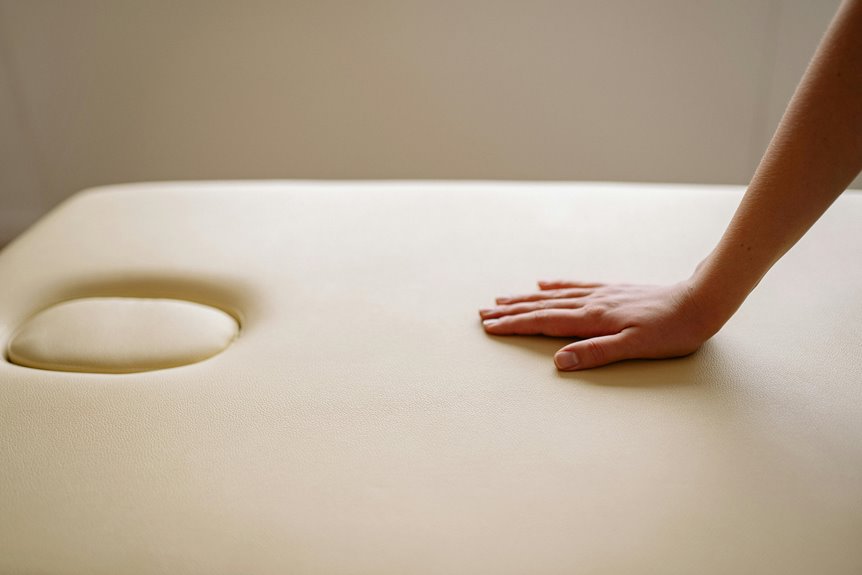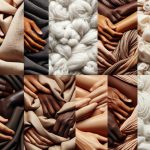Just as you wouldn’t want to bring allergens into your home unnoticed, the fabrics you choose for your furniture play an essential role in your skin’s comfort. You might not realize how much your upholstery affects your daily well-being until irritation or sneezing starts. By understanding hypoallergenic fabrics, you can create a living space that truly supports your skin’s health—here’s what you need to know before making your next choice.
Table of Contents
Key Takeaways
- Hypoallergenic upholstery fabrics minimize allergic reactions by resisting dust mites, pet dander, mold, and other common allergens.
- Natural fabrics like organic cotton and bamboo linen offer breathable, chemical-free options that soothe sensitive skin.
- Synthetic blends such as microfiber and polyester provide durable, allergen-resistant, and easy-to-clean upholstery choices.
- Choosing tightly woven, colorfast fabrics ensures allergen blockage and longevity without irritating dyes or harsh treatments.
- Proper maintenance, including regular vacuuming and gentle cleaning, preserves hypoallergenic properties and improves indoor air quality.
Understanding Hypoallergenic Fabric Characteristics
Although many fabrics can trigger allergic reactions, hypoallergenic upholstery fabrics are designed to minimize this risk. When you choose these fabrics, you’re selecting materials with a carefully considered fabric composition that resists common allergy triggers like dust mites, mold, and pet dander.
You’ll find that hypoallergenic fabrics often use tightly woven fibers or synthetic blends, which prevent allergens from settling deep within. Additionally, they tend to avoid harsh dyes and chemical treatments that can irritate sensitive skin.
Top Hypoallergenic Fabric Types for Upholstery
You’ll want to choose between natural and synthetic hypoallergenic fabrics for your upholstery.
Natural options like cotton and linen offer breathability and comfort, while synthetic fabrics can provide durability and resistance to allergens.
Understanding these choices helps you pick the best material for a healthier home environment.
Natural Hypoallergenic Fabrics
Choosing natural hypoallergenic fabrics for upholstery can greatly reduce allergens in your living space while maintaining comfort and style.
Organic cotton is an excellent choice because it’s breathable, soft, and free from harsh chemicals that can irritate your skin. You’ll appreciate how it minimizes dust mites and other allergens naturally.
Bamboo linen is another fantastic option; it’s naturally antimicrobial and moisture-wicking, which helps prevent mold and bacteria buildup on your furniture. Plus, bamboo linen offers a smooth texture that feels great against your skin.
Both fabrics are durable and eco-friendly, making them practical for everyday use.
Synthetic Hypoallergenic Options
When you want upholstery that resists allergens without sacrificing durability, synthetic hypoallergenic fabrics are a smart choice.
These materials often repel dust mites and resist moisture buildup, which helps keep your home allergen-free.
Consider these top synthetic options:
- Polyester blends – Known for durability and easy maintenance, they also resist allergens effectively.
- Microfiber materials – Their tightly woven fibers block dust and pet dander, making them ideal for sensitive skin.
- Acrylic fabrics – They’re lightweight and resistant to mildew, reducing allergen accumulation.
- Nylon blends – Durable and moisture-resistant, they prevent mold and dust mite growth.
Benefits of Using Hypoallergenic Upholstery in Your Home
Although many overlook the impact of upholstery on indoor air quality, selecting hypoallergenic fabrics can greatly reduce allergens such as dust mites, pet dander, and mold in your home.
By choosing these materials, you gain significant allergy relief, making your living space more comfortable and healthier. Hypoallergenic upholstery minimizes irritants that trigger sneezing, itching, and respiratory issues, promoting better skin comfort and overall well-being.
You’ll notice fewer flare-ups if you suffer from sensitive skin or allergies, allowing you to relax without worry. Plus, these fabrics often resist moisture and bacteria, further protecting your environment.
Investing in hypoallergenic upholstery isn’t just about aesthetics—it’s a proactive step toward creating a safe, clean, and soothing atmosphere tailored to your health needs.
Key Features to Consider When Choosing Hypoallergenic Upholstery
Understanding what makes upholstery hypoallergenic can help you make smarter decisions for your home.
Knowing the qualities of hypoallergenic upholstery guides better, healthier home choices.
When choosing hypoallergenic upholstery, focus on these key features to ascertain comfort and longevity:
- Fabric Durability: Select materials that resist wear and tear, maintaining their protective qualities over time.
- Colorfastness Considerations: Opt for fabrics that won’t fade or bleed, preserving appearance and minimizing irritants from dyes.
- Allergen Resistance: Look for tightly woven textiles that prevent dust mites, pet dander, and pollen from settling.
- Easy Maintenance: Choose upholstery that’s simple to clean, reducing buildup of allergens and bacteria.
Ideal Places to Use Hypoallergenic Upholstery Fabrics
Since hypoallergenic upholstery fabrics reduce allergens and irritants, they work best in spaces where you spend a lot of time or where sensitive individuals frequent. You’ll notice a big difference when you use them on living room sofas or bedroom furniture, creating a safer, more comfortable environment.
| Room | Recommended Furniture | Benefit |
|---|---|---|
| Living Room | Sofas, armchairs | Minimizes dust mites |
| Bedroom | Bed frames, headboards | Reduces skin irritation |
| Playroom | Cushions, bean bags | Limits exposure to allergens |
Choosing hypoallergenic fabrics in these areas helps protect your skin and enhances overall comfort in your home.
Tips for Maintaining and Caring for Hypoallergenic Upholstery
Caring for hypoallergenic upholstery is simpler than you might think, and a few consistent habits can keep your furniture fresh and allergen-free.
To maintain fabric longevity and effectiveness, follow these cleaning methods:
- Vacuum regularly using a brush attachment to remove dust and allergens without damaging fibers.
- Spot clean spills immediately with a mild detergent and water to prevent stains and fabric breakdown.
- Avoid harsh chemicals or bleach, as they can weaken the fabric’s hypoallergenic properties and durability.
- Rotate cushions frequently to distribute wear evenly and maintain the upholstery’s structure over time.
How Hypoallergenic Upholstery Enhances Indoor Air Quality
Keeping your hypoallergenic upholstery clean not only preserves its appearance but also plays a key role in improving the air you breathe indoors.
These fabrics are designed to resist trapping dust mites, pet dander, and other indoor allergens that commonly accumulate in traditional upholstery.
By minimizing these irritants, hypoallergenic materials contribute to better air purification naturally, reducing the need for excessive chemical cleaners or air fresheners.
Hypoallergenic materials naturally improve air purification, cutting down on the use of harsh chemicals and air fresheners.
When you choose hypoallergenic upholstery, you create an environment that limits airborne allergens, making it easier to maintain healthy indoor air quality.
Regular cleaning further enhances this effect by preventing buildup.
Ultimately, investing in hypoallergenic upholstery helps you breathe easier and supports a cleaner, fresher home environment.
Frequently Asked Questions
Can Hypoallergenic Upholstery Fabrics Prevent Pet Allergies Completely?
You can’t expect hypoallergenic upholstery fabrics to guarantee complete pet allergy prevention, but they greatly reduce allergens. Their fabric effectiveness helps minimize reactions, making your space more comfortable, though some allergens might still cause sensitivity.
Are Hypoallergenic Fabrics More Expensive Than Regular Upholstery Materials?
In ye olde days, you’d find hypoallergenic fabrics slightly pricier than regular ones. When you do a cost comparison, remember their fabric durability often saves you money, making them a smart choice despite higher upfront costs.
How Do Hypoallergenic Fabrics Perform in High-Traffic Commercial Spaces?
You’ll find hypoallergenic fabrics offer great high traffic durability, making them ideal for commercial applications. They resist wear and allergens well, so your space stays both comfortable and resilient even with constant use.
Can Hypoallergenic Upholstery Fabrics Be Customized in Color and Texture?
Think you’re stuck with beige? Nope! You’ll love the custom design options and color selection availability for hypoallergenic upholstery fabrics, letting you pick textures and hues that scream “you” while keeping allergens at bay.
Do Hypoallergenic Fabrics Require Special Cleaning Products or Methods?
You don’t need special cleaning products, but using gentle cleaning methods helps. Follow maintenance tips like vacuuming regularly and spot-cleaning with mild solutions to keep your fabric fresh and protect its hypoallergenic qualities effectively.
- Why Do My Linen Clothes Sometimes Develop Pills? - June 11, 2025
- How to Remove Pilling From Chenille Fabric Without Snagging It? - June 11, 2025
- What’s the Best Way to Store Clothes to Minimize Pilling Risks? - June 11, 2025







